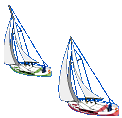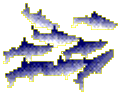When arranging an excursion to the Galapagos Islands,
one has the option to choose a three day, five day,
or seven day journey. We chose seven.
Today was the day when those who booked a three or
five day
stay were scheduled to leave the Santa Cruz. There
were only four of
us left on board now.

We went by panga, back to the
island of Santa Cruz,
an island that is
2 million
years old. We visited the area known as Caleta
Tortuga Negra, which translates to 'Black Turtle
Cove.'
There were only 4 people left now, not including the
panga operator and our naturalist, Lola.
We cruised into a series of mangrove enclosed
lagoons, a very sheltered area with calm, flat
waters. No landing is allowed here, nor is it
possible. It is a place usually filled with large
numbers of sea turtles.
It was very peaceful and quiet, with only
the sounds of the many bird songs. We saw Great Blue
Heron, pelicans, and many species of
boobies. In addition, we saw schools of mullet,
sea turtles, and some sharks, as well. Our panga
operator turned off the engines, and he
paddled the through the waters, so we could hear all
the wonderful sounds. At times, we went through
very small spaces in the mangroves. The areas were
only as wide as our little vessel, and we had to duck
down very low to pass through. The water is 'pea
soup green', but crystal
clear.
 
We
followed up our journey through the mangroves, with a
wet landing on the beach. During our visit to the
islands, a certain procedure was followed, regarding
the pangas. Once we were dropped off on an island,
the panga
returned to the Santa Cruz. It came to the island to
pick us up only when it was time for us to return to
the ship for
lunch or dinner. Today was no different. We were free
to explore on
this part of the island without a naturalist.
There were boobies,
pelicans, swallow tailed gulls, and lava gulls on the beach.


  The other couple with us was from
Germany, and we
really didn't know them at this point in time, so it
felt as though we were really alone on this
beautiful,
desolate beach. It's an awesome feeling to be in a
place like this, all alone, with no means of
communication with anyone else in the world, except one
couple who, as far as we know, doesn't speak our
language, nor do we speak theirs. It was not a
frightening feeling at all........just overwhelming.
We lapped up the sun, swam, and just enjoyed the
beach. As lunchtime approached, our panga showed up
to take us back to the ship. The other couple with us was from
Germany, and we
really didn't know them at this point in time, so it
felt as though we were really alone on this
beautiful,
desolate beach. It's an awesome feeling to be in a
place like this, all alone, with no means of
communication with anyone else in the world, except one
couple who, as far as we know, doesn't speak our
language, nor do we speak theirs. It was not a
frightening feeling at all........just overwhelming.
We lapped up the sun, swam, and just enjoyed the
beach. As lunchtime approached, our panga showed up
to take us back to the ship.

 
Once aboard the Santa Cruz, we saw lots of new faces,
as a new string of passengers arrived, to begin their
journey. At this point, the only people who were even
remotely
familiar to us, was the couple from Germany. They
invited us to sit
with them through
lunch. We learned that the husband spoke English
very well, and the wife and Ed could communicate
easily, because
Ed was born and raised in Austria, and can still
speak German quite well. Through our
conversations with them, we learned that they would
be going on the exact same expedition into the Amazon
Jungle that we would be on. We quickly became
friends.

After lunch, a brief rest, and a brief coastline
cruise, we landed on North
Seymour Island. There are a large number of pillow
lava boulders here, and a large part of this island is similar to a
dry river bed.
We had a hike of about 1 mile, half of which was on
the lava, the other half on smooth beach. We
witnessed the mating
rituals of the boobies and the frigates, and the swallow tailed gulls. The gulls lay beautiful speckled eggs.

There are two different species of frigate birds.
Although they appear much the same, their voices are
quite different. One species makes the sound of
someone rapidly
beating a snare drum. The other's voice resembles the
sound we made when we played the children's game,
'Cowboys & Indians'. Do you remember playing the
Indian, and using your hand in front of your mouth to
make a 'wah-wah' sound? That's the sound this species
of frigate makes. The male frigate has a red pouch
under his chin, similar to that of a turkey, but not
as large. When he is trying to attract a female, he
inflates this pouch
so large, that you can barely
see his head. He extends his wings, and shakes
them violently, while making his vocal noises. It is
so interesting to watch. They can continue this for
very long periods of time. Several days, if
necessary, to attract the right female.

Now, for the boobies. There are three
different species of boobies. The Red Footed
Boobie, the Masked
Boobie, and the Blue Footed
Boobie. The Blue
Footed Boobie has the most
interesting mating ritual, in my opinion. These birds
have bright blue beaks, legs, and feet. The older the
bird, the brighter the blue. In order to attract a
female, the male stands in one place, and lifts one
foot at a time, showing it off, hoping a female
will notice how beautiful he is. He spreads his wings
wide, shakes them
violently, makes a sound that resembles someone
blowing a whistle, and he flaps the sides of his neck
very rapidly. He brings gifts of sticks to the female
he is trying to woo. He repeats this ceremony over
and over.
When a female approaches, she looks him over,
deciding
whether he is beautiful enough for her. She
may take about 10 minutes, prancing around with him,
making up her mind. If he is not the one she wants,
she will just fly off. He will begin again
and again, until a female chooses him. The Blue
Footed Boobie female lays
blue eggs.

This island is
swarming with these fabulous birds.
Females are sitting on their eggs right where one has
to walk, so you must step around or over them, as
they have no fear of humans, and will not move
away. Young frigate birds, one year old, are still
sitting in their nests in the trees. They have a
very
special call to tell their mothers they are hungry,
and they do not let up until she comes along and
feeds them.
 
North Seymour Island is very wooded, and the birds
are just everywhere. You do not have to search to see
these marvelous creatures.......there's hardly room
for
the humans. There are also swallow-tailed gulls,
marine iguanas and sealions on this island.
The panga has arrived to take us back to the ship for
dinner, and the end of another exciting and
educational day.
 
|






